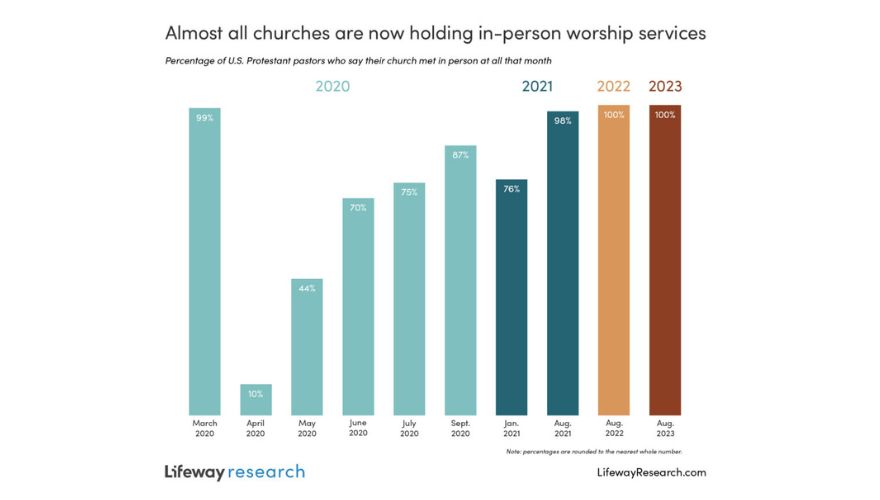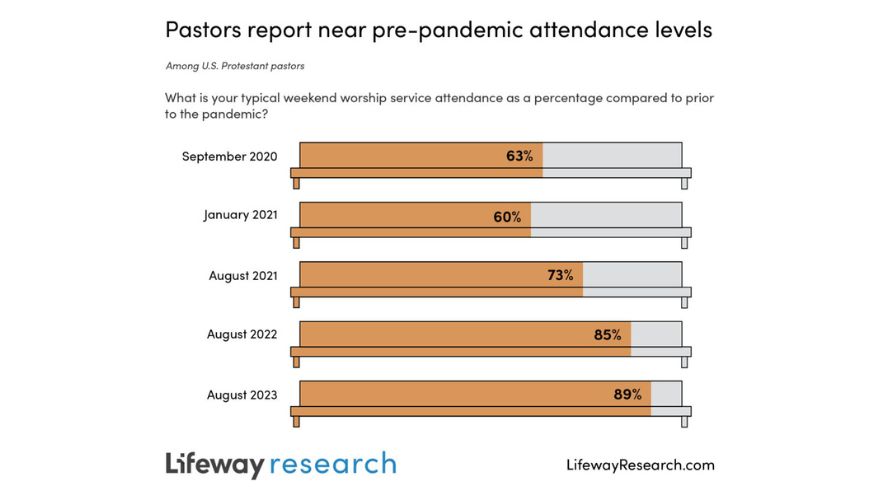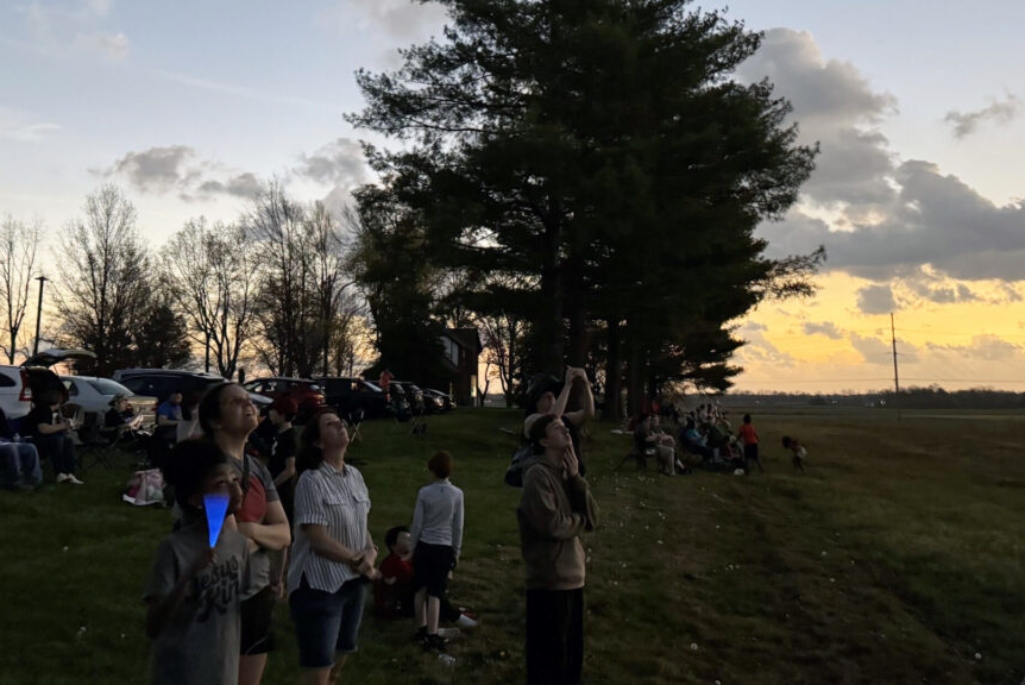
BRENTWOOD, Tenn. (BP) — For two years now, almost every church in America has been holding in-person worship services, but not every pre-pandemic worshiper has returned.
The final Lifeway Research tracking data for U.S. Protestant churches’ COVID-19 recovery finds 100 percent (rounded to the nearest whole number) met in person in August 2023, capping off a rebound since the early months of the pandemic.
In March 2020, immediately prior to the widespread COVID-19 outbreak, 99 percent of congregations held in-person worship services. The next month, only 10 percent did so. By June 2020, most churches (70 percent) were physically gathering. That percentage continued to climb, reaching 87 percent by September 2020. Following a brief dip in January 2021 to 76 percent, almost all churches held in-person services in August of that year (98 percent) and January 2022 (97 percent). Last August, 100 percent (rounded) of congregations gathered in person for worship.
“During the height of the pandemic, churches took very different approaches on whether and how to meet in person,” said Scott McConnell, executive director of Lifeway Research. “Two years ago, almost all churches that would reopen had done so.”

Attendance readjustments
While 100 percent of churches have returned, that’s not the case for everyone in the pews. But the vast majority are back. On average, churches have seen 9 in 10 churchgoers return. U.S. Protestant pastors report current attendance at 89 percent of their typical worship service crowds in early 2020, prior to the start of the pandemic. This is the high-water mark for churches attempting to recover pre-pandemic attendance levels.
In January 2021, 60 percent of pre-COVID churchgoers gathered in person with their congregations. By August of that year, that climbed to 73 percent. Last year, pastors estimated they were at 85 percent of their previous attendance.
Around 9 in 10 U.S. Protestant churchgoers (91 percent) told Lifeway Research in February 2021 that they planned to attend worship services at their church at least as much or more as they did prior to the pandemic once they felt COVID-19 was no longer an active threat. At 89 percent of their pre-pandemic attendance, churches seem to have reached most of those who expressed a desire to return.
Pandemic-related issues did not seem to be a major driving force of churchgoers changing congregations, according to a 2023 Lifeway Research study. Among regular churchgoers who have switched churches as an adult, just 14 percent mentioned COVID-19 issues as a factor.
“Some church switchers left due to disagreement over how COVID was handled at their church and others found a new church since theirs was closed for an extended period of time,” McConnell said. “But the vast majority of people have remained at their same church. In fact, most churchgoers who have changed churches as an adult arrived at their current church before the pandemic.”
Currently, 2 in 3 U.S. Protestant churches (67 percent) have fewer than 100 people for a typical worship service, including 30 percent who have fewer than 50. Around a quarter (26 percent) average between 100 and 249, while 7 percent have 250 or more.
Older pastors, those who are at least 65 years old, are the most likely to be leading the smallest congregations (47 percent). Those churches with fewer than 50 in attendance are more likely to be in the Northeast (36 percent) compared to the South (27 percent). Additionally, the smallest congregations are more likely to be Methodist (41 percent) or Presbyterian/Reformed (35 percent) compared to Baptist (23 percent).

Room to grow
While most churches declined during the pandemic, some congregations are reporting stability or even growth.
Fewer than 1 in 10 churches (8 percent) say their current attendance is less than 50 percent of what it was before the pandemic. Less than a quarter of congregations (23 percent) say they are between 50 percent and less than 70 percent of previous attendance. Around 3 in 10 (29 percent) report 70 percent to less than 90 percent. Another 17 percent say they are between 90 percent and 100 percent. Almost a quarter (23 percent) say their typical worship services today have more people than they did in early 2020.
In January 2021, 2 percent of churches reported an increase in worship service attendance compared to prior to COVID-19. That grew to 9 percent in August 2021, 17 percent last year and 23 percent today.
“Even before the pandemic, growth was not what the typical church was experiencing,” McConnell said. “COVID-19 leveled church experiences to where almost no one was seeing growth. Today, a noticeable number of churches are growing again. But mindsets have adjusted to the reality that growth is a gift from God and is not to be taken for granted.”
Pastors who are 44 years old or younger are more likely than those 65 and older to say the current attendance at their congregation is more than it was prior to the pandemic (28 percent v. 18 percent). Evangelical pastors are also more likely than their mainline counterparts to report growth over the past four years (26 percent v. 18 percent).
Denominationally, pastors at non-denominational (27 percent), Lutheran (21 percent) and Baptist churches (18 percent) are more likely than Methodists (11 percent) to report relative attendance stability with worship services between 90 percent to 100 percent compared to prior to the pandemic. Additionally, Pentecostals (27 percent), Presbyterian/Reformed (27 percent) and Baptists (23 percent) are more likely than Methodists (14 percent) to say their worship service attendance has grown since 2020.
A trend during the pandemic has been smaller churches’ ability to recover pre-COVID attendance levels quicker than other size congregations. The latest study finds this has continued. Most small churches (58 percent) are near or above their pre-pandemic worship service attendance levels.
In 2023, pastors of churches with pre-pandemic attendance of fewer than 50 are among the most likely to be between 90 percent to 100 percent of their early 2020 worship service attendance levels (23 percent). Those smallest congregations are the most likely to report growth in their August 2023 attendance, with 35 percent saying their average worship service attendance has increased in the past four years.
For more information, view the complete report and visit LifewayResearch.com.
Methodology
The phone survey of 1,004 Protestant pastors was conducted August 29, 2023 – September 20, 2023. The calling list was a stratified random sample, drawn from a list of all Protestant churches. Quotas were used for church size. Each interview was conducted with the senior pastor, minister or priest at the church. Responses were weighted by region and church size to reflect the population more accurately. The completed sample is 1,004 surveys. The sample provides 95 percent confidence that the sampling error does not exceed plus or minus 3.2 percent. This margin of error accounts for the effect of weighting. Margins of error are higher in sub-groups.
Comparisons are made to the following Lifeway Research surveys:
- an online survey of 400 Protestant pastors March 30-31, 2020
- an online survey of 470 Protestant pastors April 27-29, 2020
- an online survey of 443 Protestant pastors July 20-22, 2020
- a mixed-mode survey of 1,007 Protestant pastors Sept. 2-Oct. 1, 2020
- an online survey of 430 Protestant pastors February 1-11, 2021
- a phone survey of 1,000 Protestant pastors Sept. 1-29, 2021
- an online survey of 560 Protestant pastors Feb. 1-11, 2022
- a phone survey of 1,000 Protestant pastors Sept. 6-30, 2022
(EDITOR’S NOTE – Aaron Earls is a writer for Lifeway Christian Resources.)


